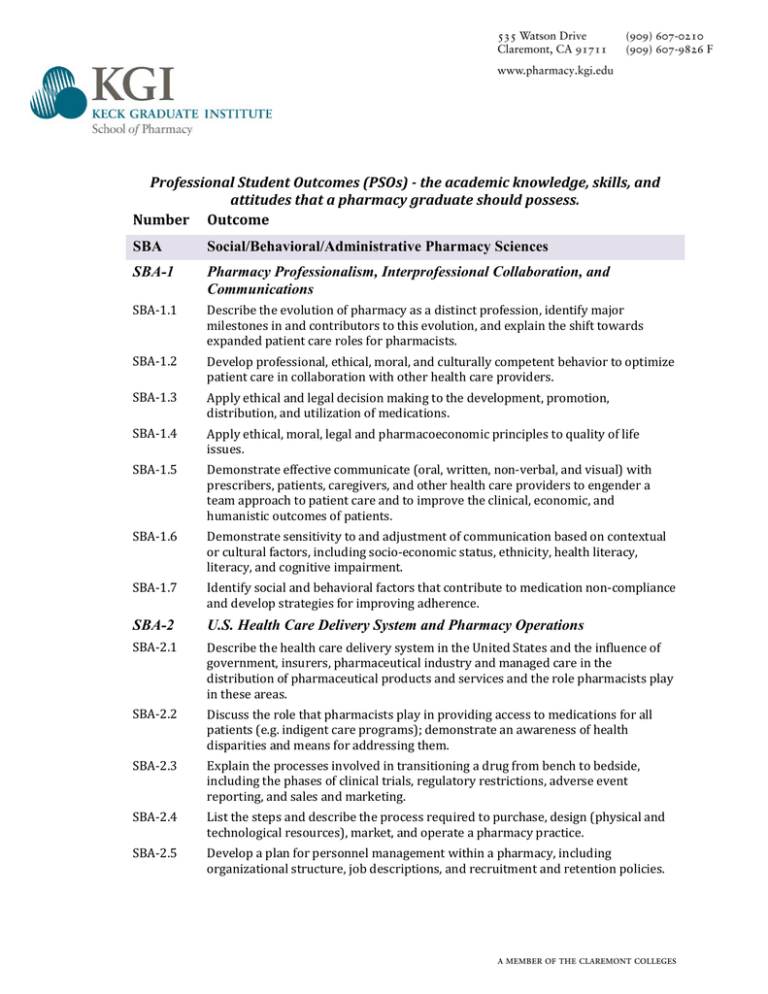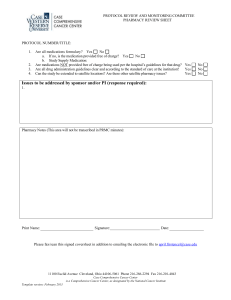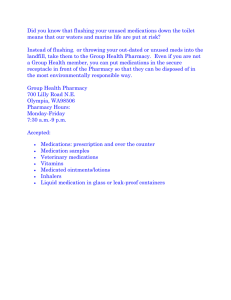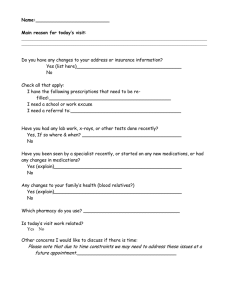Professional Student Outcomes (PSOs)
advertisement

Professional Student Outcomes (PSOs) - the academic knowledge, skills, and attitudes that a pharmacy graduate should possess. Number Outcome SBA Social/Behavioral/Administrative Pharmacy Sciences SBA-1 Pharmacy Professionalism, Interprofessional Collaboration, and Communications SBA-1.1 Describe the evolution of pharmacy as a distinct profession, identify major milestones in and contributors to this evolution, and explain the shift towards expanded patient care roles for pharmacists. SBA-1.2 SBA-1.3 SBA-1.4 SBA-1.5 SBA-1.6 SBA-1.7 SBA-2 SBA-2.1 SBA-2.2 SBA-2.3 SBA-2.4 SBA-2.5 Develop professional, ethical, moral, and culturally competent behavior to optimize patient care in collaboration with other health care providers. Apply ethical and legal decision making to the development, promotion, distribution, and utilization of medications. Apply ethical, moral, legal and pharmacoeconomic principles to quality of life issues. Demonstrate effective communicate (oral, written, non-verbal, and visual) with prescribers, patients, caregivers, and other health care providers to engender a team approach to patient care and to improve the clinical, economic, and humanistic outcomes of patients. Demonstrate sensitivity to and adjustment of communication based on contextual or cultural factors, including socio-economic status, ethnicity, health literacy, literacy, and cognitive impairment. Identify social and behavioral factors that contribute to medication non-compliance and develop strategies for improving adherence. U.S. Health Care Delivery System and Pharmacy Operations Describe the health care delivery system in the United States and the influence of government, insurers, pharmaceutical industry and managed care in the distribution of pharmaceutical products and services and the role pharmacists play in these areas. Discuss the role that pharmacists play in providing access to medications for all patients (e.g. indigent care programs); demonstrate an awareness of health disparities and means for addressing them. Explain the processes involved in transitioning a drug from bench to bedside, including the phases of clinical trials, regulatory restrictions, adverse event reporting, and sales and marketing. List the steps and describe the process required to purchase, design (physical and technological resources), market, and operate a pharmacy practice. Develop a plan for personnel management within a pharmacy, including organizational structure, job descriptions, and recruitment and retention policies. Page 2 SBA-2.6 SBA-3 SBA-3.1 SBA-3.2 SBA-3.3 SBA-3.4 BPS Describe the role and functions of informatics in workflow, prescribing, prescription review, compounding and dispensing, medication administration, medication therapy management, drug information and drug and device development. Public Health and Epidemiology Communicate and collaborate with prescribers, policy makers, members of the community and others involved in the provision of health care regarding rational drug therapy and health and wellness promotion to identify and resolve public health problems and policy. Assess the health needs of a specific patient population by analyzing epidemiologic data and identifying risk factors that would adversely affect patient health. Develop and implement population-specific, evidence-based disease management programs and protocols based upon analysis of epidemiologic and pharmacoeconomic data, medication use evaluation and risk reduction strategies. Analyze access to and formulate a plan for providing effective quality healthcare and disease prevention services, and promoting medication adherence and safe use of medications. Biomedical and Pharmaceutical Sciences BPS-1 Biomedical Sciences BPS-1.1 Describe structural components, functions, and mechanisms of interactions, regulation, and dynamic relationships at the molecular, cellular, and organ system levels. BPS-1.2 BPS-1.3 BPS-1.4 BPS-1.5 BPS-1.6 BPS-1.7 BPS-2 BPS-2.1 List the major diseases, describing deviations from normal anatomy, physiology and biochemistry, and predicting typical pathological consequences. Describe the scientific principles that explain how non-pharmacologic interventions (e.g., diet, exercise, and other life-style modifications) can prevent disease and promote patient health. Explain the principles of microbial concepts and infectious disease, host-organism interactions, host-organism differences, organism pathogenicity, clinical aspects of infection, and epidemiology. Explain fundamentals of immune response, antigen-antibody relationships and genetic basis of antibody synthesis, development and function. Describe the chemistry and metabolism of biomacromolecules and fundamentals of enzymology, replication, transcription and translation. Explain fundamentals of recombinant DNA technology and its applications to produce therapeutic agents, biomarkers, and diagnostic agents. Pharmacology and Medicinal Chemistry Classify and describe therapeutic agents (to include natural products and dietary supplements) based on chemical structure and mechanism of action; describe and apply structure activity relationships to drug-receptor interactions. Page 3 BPS-2.2 BPS-2.3 BPS-2.4 BPS-2.5 BPS-2.6 BPS-2.7 Describe the biological, chemical and physical factors that affect stability, absorption, distribution, metabolism and elimination of traditional, alternative and complementary medications. Recognize and explain the pharmacodynamic, pharmacokinetic and chemical interactions associated with a drug product’s active and inactive ingredients, including interactions with other drugs, food, herbal products, diagnostic tests, and monitoring procedures. Define basic terminology and tools used in pharmacogenomics/genetics and explain the genetic basis of variation to drug response and its role in individualizing therapeutic choices and dosage regimens. Identify and describe the mechanisms and treatments for adverse reactions, allergies, side effects and iatrogenic or drug-induced illnesses. Discuss the fundamentals of toxicology, the prevention of toxic exposure and teratogenicity, the function of poison control centers, bioterrorism and the principles of bioterrorism and emergency preparedness. Explain the use of drug screens and antidotes, and the application of toxicology to drugs of abuse and drug overdose. BPS-3 Pharmaceutics BPS-3.1 Identify and explain the pharmaceutical characteristics of drug dosage forms and delivery systems, to assure bioavailability and enhance patient compliance. BPS-3.3 Evaluate the basic pharmacokinetic properties of a drug to determine the appropriate dose, dosage form, delivery system, and route of drug administration. BPS-3.2 BPS-3.6 CPP Prepare, store, and dispense medications, compounded products, and sterile dosage forms in a manner that assures safety and efficacy, using appropriate information regarding packaging, labeling, storage, handling and administration. Use calculations to evaluate clinical parameters, to perform pharmacokinetic analyses, and to safely and accurately prepare, dispense and administer medications. Clinical Pharmacy Practice CPP-1 General Practice CPP-1.1 Demonstrate skills needed to maintain professional competency in providing public health services, medication management, and patient-centered care. CPP-1.3 Identify drug products by their generic, brand, and common names; discuss uses, indications, contraindications, warnings and precautions, adverse reactions, allergies, or drug-induced illnesses. CPP-1.2 Identify and analyze emerging issues, products, and services that may impact patient-specific outcomes, disease prevention services, public health policy, and medication use systems. Page 4 CPP-1.4 CPP-1.5 CPP-2 Develop and implement population-specific, evidence-based disease management programs and protocols based upon analysis of epidemiologic and pharmacoeconomic data, medication use criteria, medication use review, and risk reduction strategies. Communicate and collaborate with prescribers, patients, caregivers, and other involved health care providers to engender a team approach to patient care. Medication Management CPP-2.1 Comply with federal, state, and local statutes and regulations that affect pharmacy practice. CPP-2.3 Determine product availability, identify equivalence among drug products, and identify products with documented evidence of inequivalence. CPP-2.2 CPP-2.4 CPP-2.5 CPP-2.6 CPP-2.7 CPP-2.8 CPP-2.9 CPP-2.10 CPP-2.11 CPP-3 CPP-3.1 CPP-3.2 Select, prepare, and dispense medications and/or supervise the preparation of medications in a manner which promotes safe and effective use. Identify and communicate appropriate information regarding packaging, storage, handling, administration, and disposal of medications, and use of devices required to administer medications. Identify, evaluate, and communicate to the patient or health-care provider, the appropriateness of the patient’s specific pharmacotherapeutic agents, dosing regimens, dosage forms, routes of administration, and delivery systems; recommend appropriate alternatives. Assess individual patient kinetic parameters, and design or modify the drug dosage regimen to optimize patient outcomes. Prevent, recognize, and remedy medication non-adherence, misuse or abuse. Document pharmacy interventions in a patient profile, medical record, and/or electronic databases to facilitate communication and collaboration among healthcare providers. Design evidence-based disease management programs that incorporate outcome indicators, drug treatment protocols, risk reduction strategies, and education programs for health care providers and patients. Communicate and collaborate with prescribers, patients, caregivers, other involved health care providers, and administrative and supportive personnel to identify and resolve medication use problems. Devise strategies and research processes for medication use systems to minimize drug misadventures and optimize patient outcomes. Patient Assessment Identify, evaluate, and monitor patient signs and symptoms, and pharmacotherapeutic outcomes and endpoints. Identify and/or use instruments and techniques related to patient assessment and diagnosis. Page 5 CPP-3.3 CPP-3.4 CPP-3.5 CPP-4 CPP-4.1 CPP-4.2 CPP-4.3 CPP-4.4 CPP-4.5 CPP-4.6 CPP-5 Obtain, interpret and evaluate patient information (including medication, laboratory and disease state patient histories) to identify the presence of a disease or medical condition, assess the need for treatment and/or referral, and identify patient-specific factors that affect health, pharmacotherapy, and/or disease management. Gather, organize, and evaluate accurate and comprehensive patient and drugrelated information to identify ongoing or potential drug therapy problems (prescription, non-prescription, alternative and complementary medications). Evaluate patient genetic, and biosocial factors, and concurrent drug therapy relevant to the maintenance of wellness and the prevention or treatment of a disease or medical condition. Patient-Centered Care Design, implement, monitor, evaluate, and adjust patient care plans that are patientspecific and evidence-based. Educate patients or caregivers on the symptoms, significance, frequency, and management of adverse drug reactions. Facilitate patients assuming an active role in their self-care and overall health. Recommend, counsel, and monitor patient use of nonprescription medications, relevant dietary, and non-drug interventions. Demonstrate emergency first care techniques including CPR Evaluate information about pharmacoeconomic factors, dosing regimen, dosage forms, delivery systems and routes of administration to identify and select optimal pharmacotherapeutic agents for patients. Drug Information, Evidence-based Medicine, and Literature Evaluation CPP-5.1 Describe and evaluate the typical content and organization of specific sources of drug and health information for both health-care providers and consumers and determine which resource to use for responding to specific inquiries. CPP-5.2 Retrieve, analyze, and interpret the scientific, professional, and patient-oriented literature to make informed, rational, and evidence-based decisions and to provide information to patients, the public and health care professionals regarding medications, wellness and safety. CPP-5.3 CPP-5.4 CPP-5.5 Describe and manipulate commonly used statistical tests, demonstrate the management of data sets, and explain the fundamentals of research design and methodology. Evaluate and explain the suitability, accuracy, and reliability of scientific literature references by examining experimental design, statistical tests and results. Access and utilize current therapeutic guidelines. Page 6 CPP-5.6 CPP-5.7 Evaluate and apply information to promote optimal health care. Recommend and provide health care information regarding the prevention and treatment of diseases and medical conditions, including emergency patient care and vaccinations.




